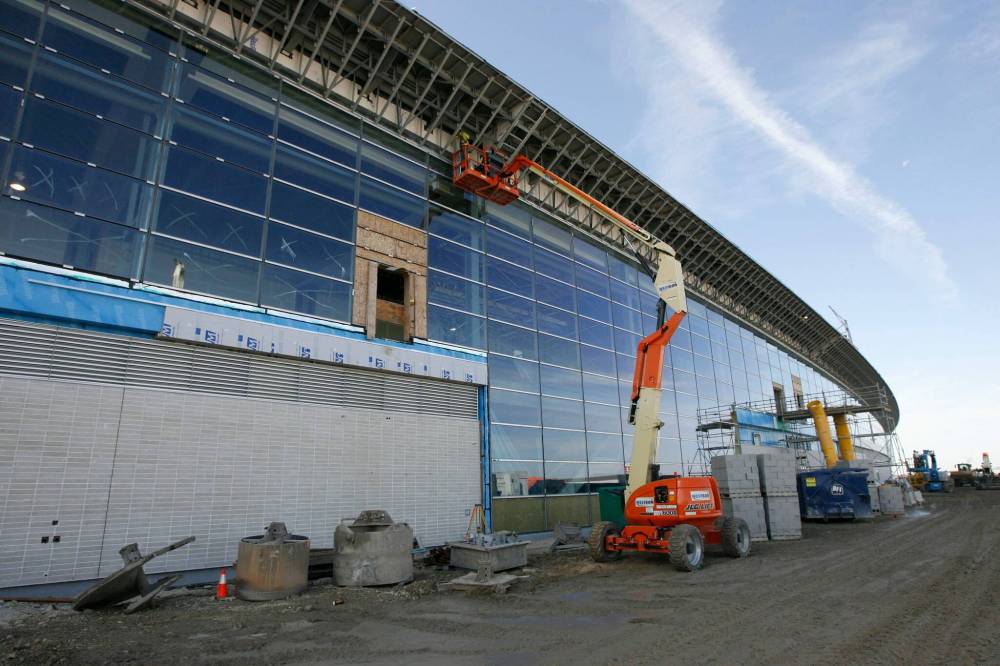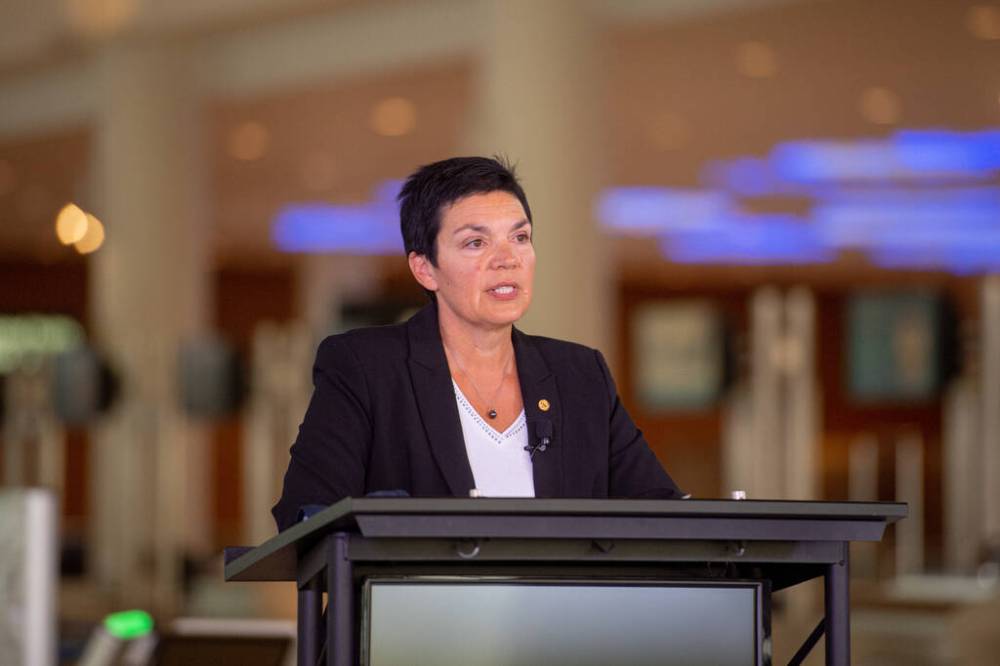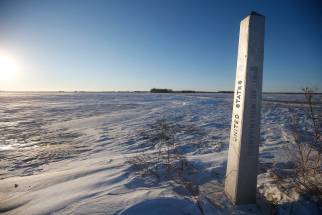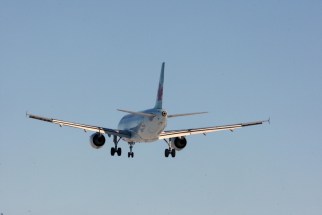Up, up and away Despite recent setbacks due to the pandemic, the Winnipeg Airports Authority celebrates 25 years and looks to the future
Read this article for free:
or
Already have an account? Log in here »
To continue reading, please subscribe:
Monthly Digital Subscription
$0 for the first 4 weeks*
- Enjoy unlimited reading on winnipegfreepress.com
- Read the E-Edition, our digital replica newspaper
- Access News Break, our award-winning app
- Play interactive puzzles
*No charge for 4 weeks then price increases to the regular rate of $19.00 plus GST every four weeks. Offer available to new and qualified returning subscribers only. Cancel any time.
Monthly Digital Subscription
$4.75/week*
- Enjoy unlimited reading on winnipegfreepress.com
- Read the E-Edition, our digital replica newspaper
- Access News Break, our award-winning app
- Play interactive puzzles
*Billed as $19 plus GST every four weeks. Cancel any time.
To continue reading, please subscribe:
Add Free Press access to your Brandon Sun subscription for only an additional
$1 for the first 4 weeks*
*Your next subscription payment will increase by $1.00 and you will be charged $16.99 plus GST for four weeks. After four weeks, your payment will increase to $23.99 plus GST every four weeks.
Read unlimited articles for free today:
or
Already have an account? Log in here »
Hey there, time traveller!
This article was published 27/01/2022 (1420 days ago), so information in it may no longer be current.
Twenty-five years ago, the Winnipeg Airports Authority was born. It took five years of negotiations with the federal government to get there.
Among other things, it took some time to wrap heads around a complex ownership and governance model: It was to be a non-share capital corporation that was not a Crown corporation beholden to or owned by either the provincial or federal governments, and it was to be operated for the benefit of the community.
One of the sticking points at the time was the hefty land lease fee the federal government demanded – 11 per cent of the revenues generated.
That is still a very expensive sore spot, inflamed even more by the dramatic drop in revenue caused by the pandemic travel restrictions.
Traffic, due to the pandemic, is down by 85 per cent and is not likely to get back to even 50 per cent of its pre-pandemic levels before the year is out. The WAA has had to lay off staff and cut operating expenses by 30 per cent.
“In the former structure the federal bureaucracy just did the job they were assigned, which was to keep the runways clean and run the airport.” – Sandy Hopkins
Yet despite the expensive rent and incalculable setback endured over the past 20 months there are few who would dispute that the first 25 years of the Winnipeg Airports Authority has been a successful undertaking.
In its first year running the airport it generated $22 million in revenue. In 2019 it was up to $140 million.
Sandy Hopkins, who chaired the task force that created the entity and then chaired the WAA through its first seven years, said there’s no question it has worked.
“In the former structure the federal bureaucracy just did the job they were assigned, which was to keep the runways clean and run the airport,” Hopkins said, “They weren’t going out to find new customers, or do things like develop the cargo business. None of that would have happened.”
While it may be argued that the new current structure has forced up the cost of air travel in Canada — it ushered in the implementation of the airport improvement fee, now $38 per flight — it has also helped transform the Winnipeg airport into one of the most important economic driver of the city.

Barry Rempel, the outgoing chief executive officer of the WAA, said it is now generating $4.3 billion in economic output.
Yes, the WAA now carries more than $600 million in debt — it increased by $100 million last year to cover the pandemic shortfalls — but it also continues to be a significant jobs generator which contributes to community wealth by adding to the tax base.
“If there is anything the pandemic has shown us is that the model we have for airports in Canada is good when traffic is growing. It is a problem when there is no revenue,” Rempel said. “Most companies would have gone to shareholders to raise capital. In our model we can only do it on the back of debt.”
Rempel, who’s been running the airport for 20 years, said it is now responsible for 18,500 jobs, which includes private industry such as StandardAero that operate on the airport campus. Twenty years ago that number was about 5,000.
Critics of airport authorities have questioned the capital spending of airport authorities in Canada. (All the major airports in Canada operate under similar governance structures.)

In a report in 2014, the Institute for Governance of Private and Public Organizations was critical of expenditures on elaborate new terminals such as the 10-year-old $585-million terminal in Winnipeg.
But Brita Chell, the current chair of the board of the WAA, argues that the airport authority is about more than the bottom line.
“The first three words of our mission statement is ‘With our community’. That is the mantra under which we operate,” she said. “That’s different than a private or publicly held corporation and the structure has worked very effectively for the WAA. We can still discharge our governance mandate but at the same time with the view to serving our community.”
That 2014 report also questioned the accountability of the airport authorities but its advocates say that because board members are nominated by a variety of community entities — the City of Winnipeg, the Winnipeg Chamber of Commerce, Economic Development Winnipeg, the Assiniboia Chamber of Commerce, the RM of Rosser, the Government of Canada, the Province of Manitoba and the WAA board itself all nominate people to the board — it is very much accountable to the people of Winnipeg and Manitoba.
Under Rempel’s watch the airport has become the largest all-freighter airport in the country, the campus now includes three hotels and a modern parkade replaced what was had been exclusively surface parking before.

There’s also the newly built Royal Aviation Museum of Western Canada, targeted to open in March. As well, development of a $62-million multi-tenant air cargo logistics facility at the site of the current Air Canada cargo building at the end of Sargent Avenue is about to get underway.
Winnipeg has always had to fight carriers to expand its destination portfolio. It is currently at a low point in that regard. United Airlines — which because of an agreement with Air Canada took over all of Air Canada’s U.S. routes from Winnipeg — cut all its cross-border traffic during the pandemic and has yet to resume, but Rempel is confident that business will return once people start travelling again. (Delta Airlines, which flies to Minneapolis, and WestJet, which flies to multiple locations, continue to operate cross-border routes.)
Chell said the board hopes to announce Rempel’s successor very soon and that person will lead the WAA through some more development that Rempel believes will be of strategic importance to the continued growth in the city.
“The next phase of development will be over on the west side of the airport,” he said. There is 2,200 acres of land between the western edge of the airport and the Perimeter Highway that needs to be serviced.
“That is where the overall community has the greatest potential for growth over the next 20 years,” he said. “There are some great plans that I believe will really serve the community well.”
martin.cash@freepress.mb.ca

Martin Cash has been writing a column and business news at the Free Press since 1989. Over those years he’s written through a number of business cycles and the rise and fall (and rise) in fortunes of many local businesses.
Our newsroom depends on a growing audience of readers to power our journalism. If you are not a paid reader, please consider becoming a subscriber.
Our newsroom depends on its audience of readers to power our journalism. Thank you for your support.







